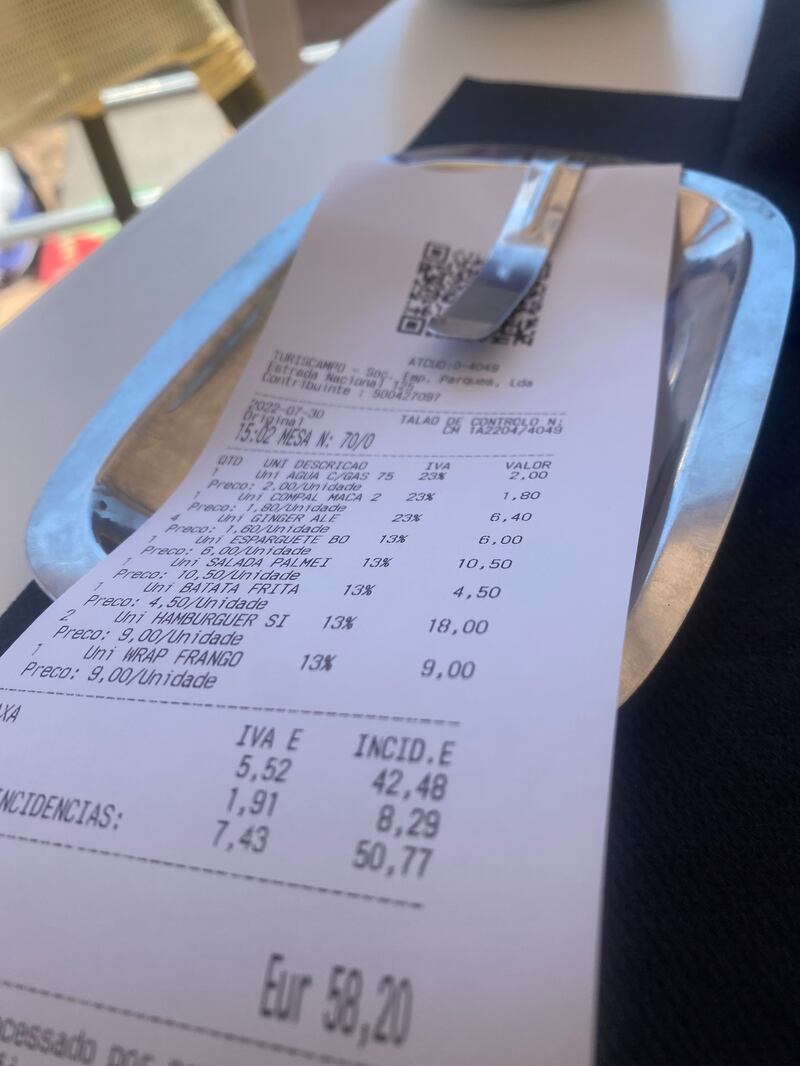It’s not often that a coffee and a pastry can delight and enrage in equal measure. On day one of a holiday in Portugal – a break booked in the winter of 2019 before the world went into Covid-19 lockdown and then came out of lockdown and almost immediately went into meltdown – I found myself staring hard at the receipt for two coffees, a chocolate milk and three pastries.
“There must be some mistake,” I mumbled, squinting with ageing eyes at the white paper covered in small numbers and unfamiliar words and then at the change I had just been handed from a five euro note. “How could all this cost €4.80?”
But there was no mistake. An excellent coffee and a pastry stuffed with magical Portuguese cream can be bought for a combined total of just €1.50 on the Algarve – a place well accustomed to dealing with high-rolling, big-spending golfer-types and villa owners from Ireland.
The camping holiday in Portugal was booked before any of us knew or cared what a wet market was and then rolled over to 2021 and then rolled over again into 2022
The well-heeled Irish are attracted to the Algarve not by the “cheap as chips” cream cakes or coffee but by the promise of endless sunshine, short flights, great seafood restaurants, crystal-clear ocean water and a population that has an astonishing command of English, one that puts our own linguistic (in)ability to shame.
But the bottom line is more central to the equation for me and I still simply cannot understand how a coffee and a pastel de nata cost so little there.
Or perhaps the better question is: why does it cost so much here?
A coffee and a pastry in Ireland will easily set you back more than €5 – and rarely will it taste as good as it does in Portugal. Such a price differential is, by any measure, absurd, and no amount of talk of higher overheads, higher taxes or a higher cost of living can justify it.

But a holiday is not all about coffees and pastries. There is a bit more to it than that and with the summer season over – or at least coming to an end – the time has come to tot up the costs.
The camping holiday in Portugal was booked before any of us knew or cared what a wet market was and then rolled over to 2021 and then rolled over again into 2022.
When I say camping, I don’t mean an in-tents holiday experience obviously. I couldn’t pitch a tent – at least one that stayed pitched – if your life depended on it. I mean one in a caravan (or a mobile home, or a chalet depending on how posh you want to sound) with a dishwasher and air conditioning and a shower and beds and a telly – the kind of camping that would make Bear Grylls cry.
While it was a self-catering type of holiday, the quality and the price of the food on offer in the restaurants in Lagos and the surrounding towns meant we were not tied to the kitchen in the same way we might have been at home
This two-bedroom chalet – let’s go posh – on the Algarve cost €2,400 for two July weeks. It wasn’t big – in truth it was pretty tiny – but it did have a decent-sized deck and with daytime temperatures rarely dipping below 30 degrees and three very child-friendly pools on site, the papal chalet was used for little more than sleeping, pouring milk over cereal and ablutions, so size really didn’t matter.
Flights for five to Faro – while pleasingly alliterative – cost a not-so-pleasing price of €1,600, give or take a few euro. Then there was the car hire. Much has been written about the price of renting a car at home and abroad going through the roof, and that certainly was the case. A five-seater Seat for two weeks set us back €1,100 – a price we were told at the car hire desk that was at least €500 more than it would have been in times past.

“At least it’s diesel,” the lovely man behind the counter said as he handed over the keys. “That should save you some money.”
Maybe, but at just more than €2 a litre, the forecourt prices there were broadly in line with the prices here. We spent a total of €55 on fuel over the course of the two weeks and an additional €18 on tolls – I can be so precise about that as we prepaid it in advance so did not have to worry about paying 55 cent here and 30 cent there every time we hit the motorways.
While it was a self-catering type of holiday, the quality and the price of the food on offer in the restaurants in Lagos and the surrounding towns meant we were not tied to the kitchen in the same way we might have been at home.
We still did a big shop though, mainly because I am a sucker for supermarkets overseas and I actually enjoy wandering the aisles marvelling at the unfamiliar products and the fresh sea food and butcher’s counters and the pastel de nata and the Kerrygold – which was only very marginally more expensive on the Algarve than it is in Kerry, incidentally.
It is one of the few products that costs more there. In the Continente supermarket, a bottle of factor 30 Nivea sun cream was €10.19; a five-litre bottle of still water cost 99 cent, a 500g of box of Kellogg’s Cornflakes had a price tag of €1.74, while a litre of full-fat fresh milk cost 84 cent. A dozen eggs came in at €3.57, while 1kg of chicken breasts cost €6.49. A bottle of Vinho Verde was four quid.
By contrast, the price of the very same brand of sun cream in an Irish supermarket of a comparable size to Continente is €21, while a five-litre bottle of water is €1.25. The cornflakes cost €2.89 and a litre of branded milk is €1.39. A dozen eggs will cost €3.69 and a kilo of chicken breast is priced at €10.59. Vinho Verde, if you can get it, will cost you at least €14.
It was different to home, wonderfully different to home. For that reason alone it was money very, very well spent.
To save anyone doing the maths, that means that a very small basket of goods that cost €27.82 in Portugal costs €54.81 in Ireland – 97 per cent more.
Buying enough food and drink to cover dinners on the deck for six nights and lunch on a further six afternoons as well as all manner of ice-creams, drinks and bottles and bottles of before- and after-sun creams cost €270.
But we did not just eat in. While the cost of eating out in Portugal has climbed since 2019, it is still much, much cheaper than at home.
An excellent lunch for five people without any booze was €58. Dinner for the same five people in restaurants that would be considered very high-end – albeit not Michelin starred – in Ireland rarely cost more than €120, a price that covered starters, mains, desserts and all drinks.

Obviously we didn’t eat like rich folk with Vilamoura villas every time we went out and there were many considerably cheaper meals – like pizza for five with a side of nachos for €41 and lunchtime sandwiches that cost no more than 20 quid – a price that included all drinks. There were eight lunches and eight dinners eaten away from the chalet, which added another €640 to the total spend.
There was also a sum of money spent by my wife and older children in a shop called Sephora while I paced patiently up and down outside. There is, however, some class of omertà on how much was actually spent in that Sephora place but seeing as how it was only a make-up shop – well, “personal care and beauty products” – it can’t have been much more than 20 quid, right?
Right?
Totting up the numbers, then, the total cost of a holiday for five people for 14 nights on the Algarve came in at €6,083 or €608 per person per week – to use the somewhat sneaky pricing vernacular so beloved of so many tour operators.
An admittedly pretty fancy holiday home in Kerry for five Popes and a Jack Russell called Toby cost the guts of four grand
It is a lot of money for sure – and it was money I am fortunate to have – but it cost almost the same as a holiday at home 12 months ago before the cost of living crisis saw the price of everything everywhere spiral.
And unlike that holiday at home, it also involved mountains of cheap as chips cream cakes and lakes of great coffee, far more eating out without feeling like we were being gouged, a lot more time in water and on sand, and a lot less time fretting about what the weather might bring and how adults and children would keep themselves entertained when the hard rain fell.
And it was different to home, wonderfully different to home. For that reason alone it was money very, very well spent.

Because when I carried out this exercise 12 months ago – back when coronavirus had taken island departures off the table and we were all talking about the joys of staycations – the results were, for me, troubling and verging on terrifying.
An admittedly pretty fancy holiday home in Kerry for five Popes and a Jack Russell called Toby cost the guts of four grand, for starters. While it was not cheap, it was one of the few properties in a tourist-friendly destination along the Wild Atlantic Way that was available at the time of booking which could accommodate all of us in a way that would not sadden the heart. It was also dramatically cheaper than two hotel rooms in any place where tourists take themselves.
And if you do not believe that, try finding a room in an any way decent hotel – and we’re not talking five-star fanciness here – anywhere in Ireland at the height of summer for less than €140 per night and see how you get on.
Anyways, we digress. The four grand for accommodation was only the start of the spending.
The Popes needed to eat and with restaurants beyond our financial means – and oftentimes closed because of Covid – it was self-catering all the way. Two weeks’ worth of groceries including food and wine, cleaning products, water pistols and a giant inflatable paddling pool cost in the region of €1,000. Yes, we could have done a Lidl shop, bought only own-brand products, turned our noses up at the water pistols and the pool – but it was holiday time for pity’s sake so the purse strings were loosened.
The cost of driving from the east coast to the southwest coast added another €200 to the total. That was back when in the golden days when a litre of fuel cost €1.40, while all manner of ridiculous wetsuits bought to stave off hypothermia from the cold ocean off the Irish coast added another couple of hundred euro to the bill.
All told, there was little change out of six grand for a two-week break for a family of five.
People will read that sentence and fly into fits of rage. Some will take that rage to social media for a good airing. This I know to be true because when I wrote about the cost of a summer of staycations this time last year, some people were so furious that I seriously started to wonder if I had spent their money on my holidays by accident.













